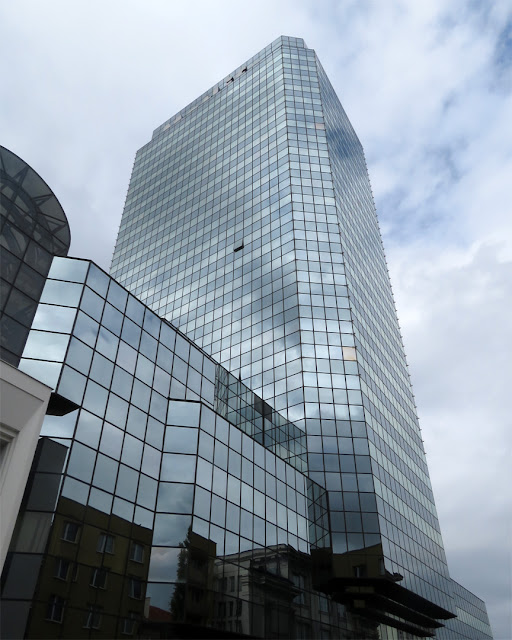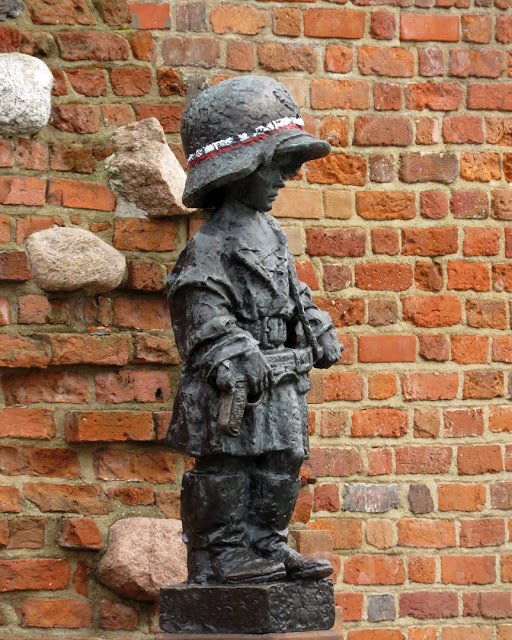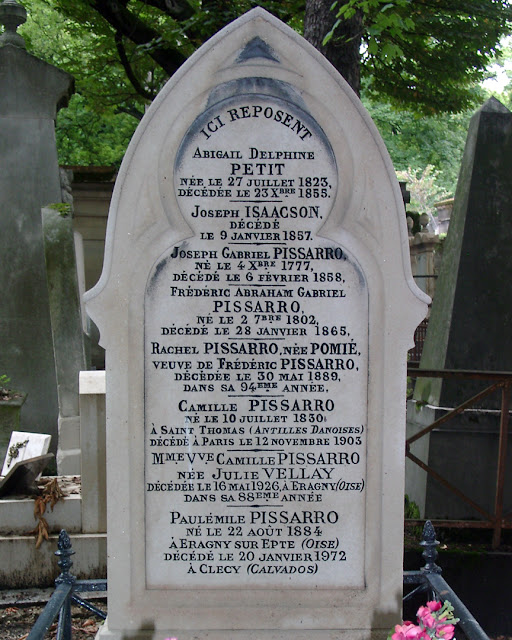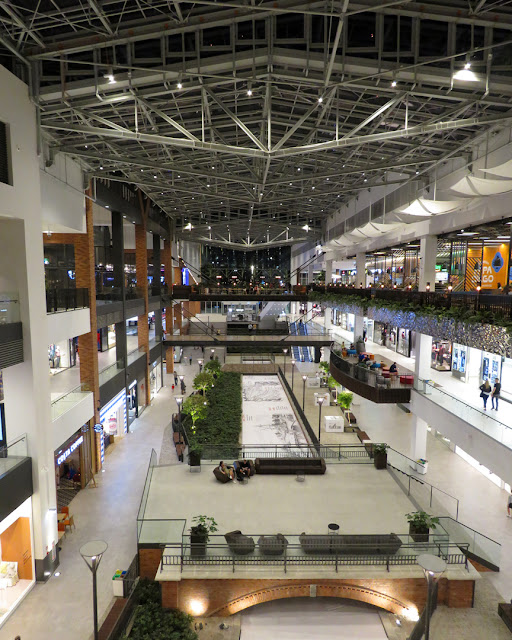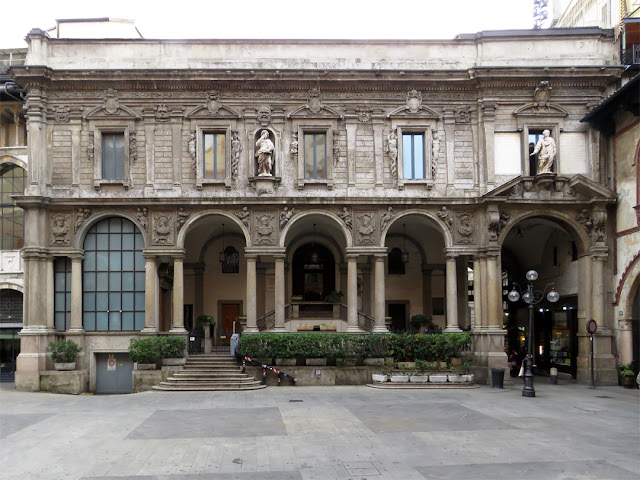Thursday, January 31, 2019
José de San Martín
José de San Martin by Carlos Maria Toto, 2001
Potsdamer Straße
Berlin, September 2011
“José Francisco de San Martín y Matorras (25 February 1778 – 17 August 1850), known simply as José de San Martín or the Liberator of Argentina, Chile and Peru, was an Argentine general and the primary leader of the southern and central parts of South America's successful struggle for independence from the Spanish Empire who served as the Protector of Peru.” (José de San Martín, Wikipedia)
Wednesday, January 30, 2019
Fortitude
Allegory of Fortitude
The four cardinal virtues by Agnolo Gaddi
Loggia dei Lanzi
Piazza della Signoria
Florence, December 2018
“On the façade of the Loggia, below the parapet, are trefoils with allegorical figures of the four cardinal virtues (Fortitude, Temperance, Justice, and Prudence) by Agnolo Gaddi. Their blue enamelled background is the work of Leonardo, a monk, while the golden stars were painted by Lorenzo de' Bicci. The vault, composed of semicircles, was done by the Florentine Antonio de' Pucci.” (Loggia dei Lanzi, Wikipedia)
Tuesday, January 29, 2019
Port of Gdańsk
Port of Gdańsk
Martwa Wisła
Gdańsk, September 2018
“The Port of Gdańsk is a seaport located on the southern coast of Gdańsk Bay in the city of Gdańsk, extending along the Vistula estuary Martwa Wisła (Dead Vistula), Port Channel and Kashubia Canal. It is one of the largest seaports on the Baltic Sea.” (Port of Gdańsk, Wikipedia)
Monday, January 28, 2019
Sarah Bernhardt
Grave of Sarah Bernhardt (1844-1923)
Cimetière du Père-Lachaise, (Père Lachaise Cemetery)
Quartier du Père-Lachaise, 20th arrondissement
Paris, July 2006
“Sarah Bernhardt (born Henriette-Rosine Bernard; 22 or 23 October 1844 – 26 March 1923) was a French stage actress who starred in some of the most popular French plays of the late 19th and early 20th centuries, including La Dame Aux Camelias by Alexandre Dumas, fils; Ruy Blas by Victor Hugo, Fédora and La Tosca by Victorien Sardou, and L'Aiglon by Edmond Rostand. She also played male roles, including Shakespeare's Hamlet. Rostand called her ‘the queen of the pose and the princess of the gesture’, while Hugo praised her ‘golden voice’. She made several theatrical tours around the world, and was one of the first prominent actresses to make sound recordings and to act in motion pictures. She is also linked with the success of artist Alphonse Mucha in giving him his ‘big break’ in Paris. Alphonse Mucha would become one of the most sought after artist of this time for his art nouveau style.” (Sarah Bernhardt, Wikipedia)
Sunday, January 27, 2019
A Modern Staircase
The new staircase by Marco Dezzi Bardeschi, 1986
Palazzo della Ragione
Piazza Mercanti
Milan, November 2016
Saturday, January 26, 2019
Błękitny Wieżowiec
Błękitny Wieżowiec (Blue Skyscraper)
Plac Bankowy, Śródmieście
Warsaw, September 2018
“Błękitny Wieżowiec (Blue Skyscraper) is a building located in Bank Square in Warsaw. It stands in the place that was occupied before World War II by Warsaw's largest synagogue, the Great Synagogue, which was blown up by the Germans in 1943. Initial concepts for the construction of the skyscraper had been put forward in the 1950s, but construction finally began in the 1970s and was suspended shortly after the main structure was built. The unused construction was then often called the ‘golden towers’ because of the colour of the facade. The work resumed in the late 1980s and was completed in 1991. The project was modified by a Belgrade-based company, replacing the copper-coloured facade with colourless reflective material, which gives a sky-blue reflection on a clear day (hence the current name). The skyscraper is 120 meters high and has 28 storeys. Prominent former tenants include Peugeot and Sony which had large neon signs on the building.” (Błękitny Wieżowiec, Wikipedia)
Friday, January 25, 2019
Têtes et queue
“Têtes et queue” (Heads and Tail) by Alexander Calder, 1965
Forecourt terrace of the Neue Nationalgalerie (New National Gallery)
Potsdamer Straße
Berlin, September 2011
Thursday, January 24, 2019
Temperance
Allegory of Temperance
The four cardinal virtues by Agnolo Gaddi
Loggia dei Lanzi
Piazza della Signoria
Florence, December 2018
“On the façade of the Loggia, below the parapet, are trefoils with allegorical figures of the four cardinal virtues (Fortitude, Temperance, Justice, and Prudence) by Agnolo Gaddi. Their blue enamelled background is the work of Leonardo, a monk, while the golden stars were painted by Lorenzo de' Bicci. The vault, composed of semicircles, was done by the Florentine Antonio de' Pucci.” (Loggia dei Lanzi, Wikipedia)
Wednesday, January 23, 2019
Kładka Ojca Bernatka
Kładka Ojca Bernatka (Father Bernatek Footbridge), 2010
Sculptures by Jerzy Kędziora, 2016
ul. Mostowa and ul. Nadwiślańska
Kraków, September 2018
“Opened on September 30th, 2010, the Father Bernatek Footbridge (Kładka Ojca Bernatka) straddles the Wisła River just south of the centre, linking the districts of Kazimierz and Podgórzebetween ul. Mostowa and ul. Nadwiślańska where several road bridges had stood in its place before, the last being dismantled way back in 1925. The leaf-shaped, 130m structure accommodates both pedestrians and cyclists with its twin walkway design by local architect Andrzej Getter. Though a source of controversy during its development (largely due to coming in over budget at a sobering 38 million złoty), the Bernatek bridge is now a beloved part of the urban landscape, both for its convenience and aesthetic appeal. The bridge has played a key role in the revitalisation of the two areas it connects between Plac Wolnica and Rynek Podgórski, which is now not only an ideal destination for an alternative pub crawl, but also a romantic stroll. It's here that Cracovian couples have adopted the increasingly popular (and unoriginal) tradition of attaching padlocks engraved with their names to the railings of the bridge, before throwing the keys into the Wisła (while the rest of us throw up in our mouths) as evidence of their unbreakable bond and commitment to each other. The success and influence of the bridge will hopefully inspire the city to follow through on plans it has for a similar pedestrian river crossing close to Wawel Castle. Since 2016, the bridge has been adorned with nine acrobatic, gravity-defying sculptures by Jerzy Kędziora, which we hope stay there forever.” (Bernatek Footbridge, In Your Pocket)
Sculptures by Jerzy Kędziora, 2016
ul. Mostowa and ul. Nadwiślańska
Kraków, September 2018
“Opened on September 30th, 2010, the Father Bernatek Footbridge (Kładka Ojca Bernatka) straddles the Wisła River just south of the centre, linking the districts of Kazimierz and Podgórzebetween ul. Mostowa and ul. Nadwiślańska where several road bridges had stood in its place before, the last being dismantled way back in 1925. The leaf-shaped, 130m structure accommodates both pedestrians and cyclists with its twin walkway design by local architect Andrzej Getter. Though a source of controversy during its development (largely due to coming in over budget at a sobering 38 million złoty), the Bernatek bridge is now a beloved part of the urban landscape, both for its convenience and aesthetic appeal. The bridge has played a key role in the revitalisation of the two areas it connects between Plac Wolnica and Rynek Podgórski, which is now not only an ideal destination for an alternative pub crawl, but also a romantic stroll. It's here that Cracovian couples have adopted the increasingly popular (and unoriginal) tradition of attaching padlocks engraved with their names to the railings of the bridge, before throwing the keys into the Wisła (while the rest of us throw up in our mouths) as evidence of their unbreakable bond and commitment to each other. The success and influence of the bridge will hopefully inspire the city to follow through on plans it has for a similar pedestrian river crossing close to Wawel Castle. Since 2016, the bridge has been adorned with nine acrobatic, gravity-defying sculptures by Jerzy Kędziora, which we hope stay there forever.” (Bernatek Footbridge, In Your Pocket)
Tuesday, January 22, 2019
Swan and cygnet
Swan and cygnet
Donaupark, Donaustadt
Vienna, June 2018
“Young birds, called cygnets, are not the bright white of mature adults, and their bill is dull greyish-black, not orange, for the first year. The down may range from pure white to grey to buff, with grey/buff the most common. The white cygnets have a leucistic gene. Cygnets grow quickly, reaching a size close to their adult size in approximately three months after hatching. Cygnets typically retain their grey feathers until they are at least one year old, with the down on their wings having been replaced by Flight feathers earlier that year. All mute swans are white at maturity, though the feathers (particularly on the head and neck) are often stained orange-brown by iron and tannins in the water.” (Mute swan, Wikipedia)
Monday, January 21, 2019
Rivoluzione
Detail of the “Rivoluzione” (Revolution)
Monument to Giuseppe Garibaldi by Ettore Ximenes, 1895
Largo Cairoli
Milano, November 2016
Sunday, January 20, 2019
Gdańsk Shakespeare Theatre
Gdańsk Shakespeare Theatre (Gdański Teatr Szekspirowski) by Renato Rizzi, 2014
Wojciecha Bogusławskiego
Gdańsk, September 2018
“The Gdańsk Shakespeare Theatre (Polish: Gdański Teatr Szekspirowski) is a Shakespearean theatre in Gdańsk, Poland. It is built on the site of a 17th-century theatre, known as the Fencing School, where English travelling players performed works of English Renaissance theatre. The leading figure in the project to construct the new theatre is Jerzy Limon, a founder of the Gdańsk Shakespeare Festival. It has been built by architect Renato Rizzi in the light of Limon's research which suggests that the Fencing School was modelled on the Fortune Playhouse in London. Though not an attempt at an exact reproduction, the new theatre combines elements from the design of these earlier theatres with modern technology. It opened in September 2014.” (Gdańsk Shakespeare Theatre, Wikipedia)
Saturday, January 19, 2019
Echo I
“Echo I” by Bernhard Heiliger, 1987
Kammermusiksaal der Philharmonie
Herbert-von-Karajan-Straße
Berlin, September 2011
“Bernhard Heiliger (11 November 1915, Stettin – 25 October 1995, Berlin) was a German artist. He was considered ‘West Germany's foremost sculptor’, and his large public artworks are a prominent presence in many German cities, especially Berlin.” (Bernhard Heiliger, Wikipedia)
Friday, January 18, 2019
Justice
Allegory of Justice
The four cardinal virtues by Agnolo Gaddi
Loggia dei Lanzi
Piazza della Signoria
Florence, December 2018
“On the façade of the Loggia, below the parapet, are trefoils with allegorical figures of the four cardinal virtues (Fortitude, Temperance, Justice, and Prudence) by Agnolo Gaddi. Their blue enamelled background is the work of Leonardo, a monk, while the golden stars were painted by Lorenzo de' Bicci. The vault, composed of semicircles, was done by the Florentine Antonio de' Pucci.” (Loggia dei Lanzi, Wikipedia)
Thursday, January 17, 2019
Mały Powstaniec
Mały Powstaniec (Little Insurgent) by Jerzy Jarnuszkiewicz, 1983
Podwale, Stare Miasto (Old Town)
Warsaw, September 2018
“Mały Powstaniec is a statue in commemoration of the child soldiers who fought and died during the Warsaw Uprising of 1944. It is located on Podwale Street, next to the ramparts of Warsaw’s Old Town. The statue is of a young boy wearing a helmet too large for his head and holding a submachine gun. It is reputed to be of a fighter who went by the pseudonym of ‘Antek’, and was killed on 8 August 1944 at the age of 13. The helmet and submachine gun are stylized after German equipment, which was captured during the uprising and used by the resistance fighters against the occupying forces. Jerzy Jarnuszkiewicz created the design for the monument in 1946, which was later used to make smaller copies of its present state. The statue was unveiled on 1 October 1983 by Professor Jerzy Świderski – a cardiologist who was a courier for the resistance during the uprising (pseudonym: ‘Lubicz’) serving in the Gustaw regiment of the Armia Krajowa.” (Mały Powstaniec, Wikipedia)
Wednesday, January 16, 2019
Camille Pissarro
Grave of Camille Pissarro (1830-1903)
Cimetière du Père-Lachaise, (Père Lachaise Cemetery)
Quartier du Père-Lachaise, 20th arrondissement
Paris, July 2006
“Camille Pissarro (10 July 1830 – 13 November 1903) was a Danish-French Impressionist and Neo-Impressionist painter born on the island of St Thomas (now in the US Virgin Islands, but then in the Danish West Indies). His importance resides in his contributions to both Impressionism and Post-Impressionism. Pissarro studied from great forerunners, including Gustave Courbet and Jean-Baptiste-Camille Corot. He later studied and worked alongside Georges Seurat and Paul Signac when he took on the Neo-Impressionist style at the age of 54. In 1873 he helped establish a collective society of fifteen aspiring artists, becoming the ‘pivotal’ figure in holding the group together and encouraging the other members. Art historian John Rewald called Pissarro the ‘dean of the Impressionist painters’, not only because he was the oldest of the group, but also ‘by virtue of his wisdom and his balanced, kind, and warmhearted personality’. Paul Cézanne said "he was a father for me. A man to consult and a little like the good Lord", and he was also one of Paul Gauguin's masters. Pierre-Auguste Renoir referred to his work as ‘revolutionary’, through his artistic portrayals of the ‘common man’, as Pissarro insisted on painting individuals in natural settings without ‘artifice or grandeur’. Pissarro is the only artist to have shown his work at all eight Paris Impressionist exhibitions, from 1874 to 1886. He ‘acted as a father figure not only to the Impressionists’ but to all four of the major Post-Impressionists, Cézanne, Seurat, Gauguin, and van Gogh.” (Camille Pissarro, Wikipedia)
Tuesday, January 15, 2019
“Sforza” Clock
Clock, Filarete Tower, 1905
Castello Sforzesco (Sforza Castle)
Piazza Castello
Milan, November 2016
“The current edifice is the result of a tireless study of the available documents and iconography, by Luca Beltrami, in order to reconstruct the tower as faithfully to the renaissance original as possible. Inaugurated in 1905, the Filarete tower was dedicated to King Umberto I, assassinated only 5 years earlier in Monza. Beltrami inserted a clock into the top cubic section of the tower, whose radiant sun motif was inspired by the Sforza coat of arms.” (The Filarete Tower, Castello Sforzesco)
Monday, January 14, 2019
Cricoteka
Cricoteka - Museum of Tadeusz Kantor by Wizja + nsMoonStudio, 2014
Nadwiślańska
Kraków, September 2018
“Cricoteka building has a form of two intersecting arches made of spatial reinforced concrete steel truss based on two shafts. The third pillar is a steel, double-rocker. The branch support truss’s given implementing raise equal to their constant deflection under load and utility. Due to the complex geometry and other extensions, the raise values of the executive are different, which was included in the design of the cross. Rely on reinforced concrete prefabricated shafts was implemented through five pot bearings and one of the lens. Horizontal forces from the upper belt trusses are carried by special anchoring structures embedded in the shafts. The horizontal forces from the lower belts are passed in turn by the thrust on the walls of the shafts." (Museum of Tadeusz Kantor, ArchDaily)
Sunday, January 13, 2019
Schalenbrunnen
Schalenbrunnen (Bowl fountain)
Monbijoupark
Oranienburger Straße
Berlin, September 2011
“Monbijou Park is a park in Mitte, a district of Berlin, Germany. The park is bounded to the south by the river Spree, to the west by Monbijoustraße, and to the north Oranienburger Straße and Monbijouplatz. It is close to the Friedrichstadt Palast, Neue Synagogue and the Sophienkirche.” (Monbijou Park, Wikipedia)
Saturday, January 12, 2019
Prudence
Allegory of Prudence
The four cardinal virtues by Agnolo Gaddi
Loggia dei Lanzi
Piazza della Signoria
Florence, December 2018
“On the façade of the Loggia, below the parapet, are trefoils with allegorical figures of the four cardinal virtues (Fortitude, Temperance, Justice, and Prudence) by Agnolo Gaddi. Their blue enamelled background is the work of Leonardo, a monk, while the golden stars were painted by Lorenzo de' Bicci. The vault, composed of semicircles, was done by the Florentine Antonio de' Pucci.” (Loggia dei Lanzi, Wikipedia)
Friday, January 11, 2019
Forum Gdańsk
Forum Gdańsk
Targ Sienny
Gdańsk, September 2018
“The Forum is located in Targ Sienny and Targ Rakowy – both historic places for Gdansk trade. Previously, the area was crisscrossed by railway tracks, as well as housing what remained of Gildia – a commercial centre built in the 90s and which was closed down 6 years ago. The location was examined by a team of archaeologists, whose findings will be presented in special display cases along the boulevard at Kanał Raduni. Construction work began in 2015, breathing new life into the Forum’s surroundings and continuing the commercial tradition of the city. No less than 1/3 of Forum Gdańsk is made up of green spaces. This area of more than 2 hectares will be planted with 80 various species of vegetation – 33 thousand plants in total. 2 veteran trees also grow here – a horse-chestnut and an ash. This results in a unique ecosystem in the heart of the city, which will draw butterflies and chirping birds. Katarzyna Bellingham designed the space so that it changes with the seasons – from the juiciness of spring greenery, to the blue and violet, as well as pink and purple of spring and autumn in full swing. In addition, ornamental grasses and shrubs will decorate the area in autumn and winter.” (About Forum, Forum Gdańsk)
Thursday, January 10, 2019
Statue of Winston Churchill
Statue of Winston Churchill by Ivor Roberts-Jones, 1973
Parliament Square
London, October 2009
“The statue of Winston Churchill in Parliament Square, London, is a bronze sculpture of the former British prime minister Winston Churchill, created by Ivor Roberts-Jones. It is located on a spot referred to in the 1950s by Churchill as "where my statue will go". It was unveiled in 1973 by his widow Clementine, Baroness Spencer-Churchill, at a ceremony attended by the serving Prime Minister and four former Prime Ministers, while Queen Elizabeth II gave a speech. The statue is one of twelve statues on or around Parliament Square, most of well-known statesmen. The statue is 12 feet (3.7 m) high and is made of bronze. It was sculpted by Ivor Roberts-Jones and is located on the main green of Parliament Square, opposite the Palace of Westminster. It is said that the artist's friend Kyffin Williams stood in as a model for Churchill. The statue shows Winston Churchill standing with his hand resting on his walking stick and wearing a military greatcoat. His pose is based on a well-known photograph of Churchill inspecting the Chamber of the House of Commons after it had been destroyed by bombing on the night of 10–11 May 1941. The plinth is 8 feet (2.4 m) high with ‘Churchill’ inscribed on it in large capital letters. A proposal to insert pins standing out of the statue's head was turned down in the 1970s – the pins were intended to stop wild birds from sitting on its head. The Churchill Statue Committee had concerns during the statue's development process that it looked ‘a little too much’ like the Italian Fascist leader Benito Mussolini. Whilst the head was still only cast in plaster, a report on it stated that, ‘At the moment the head is undoubtedly like Churchill, but perhaps not quite right of him at the pinnacle of his career. The cheeks, the eyes, the forehead and the top of the head require improvement. I told Mr. Roberts-Jones that above the eyes I thought I was looking at Mussolini.’ Roberts-Jones agreed to modify the sculpture to reduce the dome of the head in order to lower the forehead.” (Statue of Winston Churchill, Wikipedia)
Wednesday, January 9, 2019
Palazzo delle Scuole Palatine
Palazzo delle Scuole Palatine (Palace of the Palatine School)
Piazza Mercanti
Milan, November 2016
“The Palazzo delle Scuole Palatine (Palace of the Palatine School) is a historic building of Milan, Italy, located in Piazza Mercanti, the former city centre in the Middle Ages. It served as the seat of the most prestigious higher school of medieval Milan. Many notable Milanese scholars of different ages studied or taught in these schools; Augustine of Hippo and Cesare Beccaria, among others, served as teachers in the Palatine. The current building dates back to 1644, when it replaced an older one, which had the same function and was destroyed by a fire. The school was established in Piazza Mercanti under Giovanni Maria Visconti. In 1644, they were destroyed by a fire, and rebuilt based on the prestigious model of the nearby Palazzo dei Giureconsulti, by architect Carlo Buzzi. The building is decorated with several monuments, including a plaque with an epigram by Ausonius celebrating Milan as the ‘New Rome’ of the 4th century, a statue of Augustine by sculptor Pietro Lasagna, and a statue of Ausonius.” (Palazzo delle Scuole Palatine, Wikipedia)
Tuesday, January 8, 2019
Gospoda Kwiaty Polskie
Gospoda Kwiaty Polskie
Wąski Dunaj, Stare Miasto (Old Town)
Warsaw, September 2018
“Within a heartbeat of the Rynek Gospoda Kwiaty Polskie serves up cracking Polish country cooking inside an interior that blossoms with folk art and ceramics. Primary school paintings of happy sunflowers adorn every available space and diners seem happy to sacrifice the formality of nearby restaurants in return for big portions of bargain Polski classics.” (Gospoda Kwiaty Polskie, Warsaw in Your Pocket)
Monday, January 7, 2019
Sunday, January 6, 2019
Lion of Wood
“Leone” (Lion) by Sedicente Moradi, 2018
Piazza del Carmine
Florence, December 2018
“The monastery once housed the Carmelites, who are credited with the foundation of the piazza in the early 13thand 14th centuries, when the church was sanctuary from the dangers outside the city wall. From these origins until a re-design in 1950, the space was open, even empty. New to the piazza is a sculpture in wood of a lion by Sedicente Moradi, which was unveiled as part of the dedication on June 16.” (The (Re)Birth of a Piazza, Viking Fusion)
Saturday, January 5, 2019
Wawel Hill
Wawel Castle, Wawel Hill
Seen from the Dębnicki Bridge
Stare Miasto (Old Town)
Kraków, September 2018
“The Wawel Castle is a castle residency located in central Kraków, Poland. Built at the behest of King Casimir III the Great, it consists of a number of structures situated around the Italian-styled main courtyard. The castle, being one of the largest in Poland, represents nearly all European architectural styles of medieval, renaissance and baroqueperiods. The Wawel Royal Castle and the Wawel Hill constitute the most historically and culturally significant site in the country. In 1978 it was declared a UNESCO World Heritage Site as part of the Historic Centre of Kraków.” (Wawel Castle, Wikipedia)
Friday, January 4, 2019
François-Vincent Raspail
Grave of François-Vincent Raspail (1794-1878)
Cimetière du Père-Lachaise, (Père Lachaise Cemetery)
Quartier du Père-Lachaise, 20th arrondissement
Paris, July 2006
“Raspail was born in Carpentras, Vaucluse. A member of the republican Carbonari society and Freemasonry, where he met François Arago, Victor Schoelcher and Auguste Blanqui,[1] Raspail was imprisoned during Louis Philippe's reign (1830–1848) and was a candidate for presidency of the Second Republic in December 1848. However, he was then involved in the attempted revolt of 15 May 1848 and in March 1849 was again imprisoned as a result. After Louis Napoleon's 2 December 1851 coup, his sentence was commuted to exile, from which he returned to France only in 1862. In 1869, during the liberal phase of the Second Empire (1851–1870), he was elected deputy from Lyons. He remained a popular republican during the French Third Republic after the short-term Paris Commune in 1871.” (François-Vincent Raspail, Wikipedia)
Thursday, January 3, 2019
Santo Spirito Tower
Santo Spirito Tower
Castello Sforzesco (Sforza Castle)
Piazza Castello
Milan, November 2016
“Wanted by Francesco Sforza to strengthen the side of the castle facing the city and designed by the architect, Bartolomeo Gadio in 1452, these round towers clad in rusticated serizzo constituted a rather original piece of building on the Lombard scene. They were highly appreciated and cited by visiting nobility and ambassadors as an element that characterised the ancient manner. The towers, which contain six vaulted rooms and at one point housed prisons, were lowered in the 1500s and then again by the Austrians in 1848. The current roofing is the work of Beltrami, who restored the towers to their original height following the drawings made by the French engineering corps in 1800. The Carmine tower, which for some years was relegated to the function of a drinking-water cistern, today houses the Art Library.” (Carmine and Santo Spirito Towers, Castello Sforzesco)
Wednesday, January 2, 2019
Three Ladies
Three ladies
Volksgarten
Hofburg, Innere Stadt
Vienna, June 2018
“The Volksgarten area was originally used for fortifications. Between 1596 and 1597, a fortress wall was built on the eastern side of park. In 1639, additional fortifications were built on the southern side. In 1809, these fortifications were destroyed by Napoleon's French troops. Between 1817 and 1821, the area near Ballhausplatz square was converted to gardens originally intended for a private garden for the archdukes. These plans were changed through a proposal by the court garden administration to turn the area into the first public park in the city. On 1 March 1823, the park was officially opened. Starting in 1825, the name Volksgarten was commonly used. In 1862, the gardens were extended toward Ringstraße after the city moat had been filled in.” (Volksgarten, Wikipedia)
Tuesday, January 1, 2019
Giordano-Bruno-Denkmals
Giordano-Bruno-Denkmals (Giordano Bruno Monument) by Alexander Polzin, 2008
Bahnhof Potsdamer Platz
Potsdamer Platz
Berlin, September 2011
Subscribe to:
Posts (Atom)






